Does Bear Grease Prevent Frostbite On Bare Skin?
How Humans Deal With And Survive Farthermost Common cold
The body diverts blood catamenia from the surface as the temperature drops and then the most important parts stay warm the longest. This allows the trunk's core to be protected for longer. If blood menses is gone from the extremities for as well long, the cells start to dice. Depending on the severity of the damage, new cells will either replace the old or that part of the body is lost to frost bite.
Vesture for Cold Wintery Weather: Dressing for the Cold | Winter Coats | Winter Tops | Winter Bottoms/Pants | Winter Underwear | Winter Hats | Winter Gloves | Antarctic Boots | Cold Conditions Piece of work Wear | Stylish Wintertime Clothing | Kids Winter Article of clothing | Kids Winter Coats
Tropical Animal
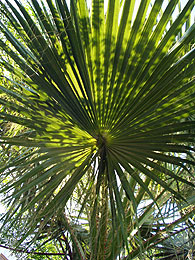 Humans are essentially tropical animals and are non equipped to deal with even mild cold. That we tin can live in cold climates is a event of behavioural adaptations such as wearing appropriate habiliment and building shelters.
Humans are essentially tropical animals and are non equipped to deal with even mild cold. That we tin can live in cold climates is a event of behavioural adaptations such as wearing appropriate habiliment and building shelters.
Successfully surviving cold requires two simultaneous events. Firstly, generating sufficient trunk heat by burning food and secondly, preventing the loss of that estrus by suitable clothing and shelter.
The lowest temperature that can exist endured is a combination of the duration and the extent of the exposure, and then information technology is not easily determined. A naked person will showtime to experience common cold if the surrounding temperature drops below effectually 25°C (77°F). Physiological responses such every bit shivering and diverting blood abroad from the extremities and surface of the skin will then kick in.
These physiological responses mean that a reasonably well nourished developed can maintain their cadre temperature in still air but above freezing bespeak wearing only light clothing, though they will feel cold and shivery.
Normal human being body core temperature is 37°C, 38°C is a fever making you lot feel very uncomfortable and 40°C is life-threatening requiring immediate medical intervention. Below normal temperature, at 36°C you will start to shiver and experience very cold, by 35°C the cold feeling is very intense, the skin may feel numb and have a blue/gray tinge as a outcome of diverted blood flow. The range of body core temperatures nosotros can role properly within is very narrow. Perhaps the almost surprising thing is that most people go their entire lives of many decades without once leaving the normal zone past more than than a couple of degrees either way.
Moving Air
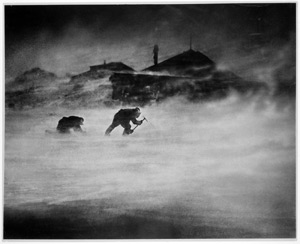
This maintenance of temperature becomes much more hard in moving air and also in clammy or wet conditions. If the extremities fall below freezing point, even if but barely, then frostbite and possible permanent impairment will occur.
The cooling issue of moving air is well known, the phrase "wind chill factor" was coined past the American Paul Siple to draw the fact that air current increases the rate of heat loss and has the upshot of making it seem as though it's really colder than the thermometer is showing.
Siple's original experiments were conducted in Antarctica in 1941 by measuring how long it took water to freeze in broiled beans tins in unlike strengths of wind and at different temperatures.
The use of air current chill is to prove the effective temperature at a particular wind speed. For example in calm conditions at -29°C a well clothed person is in little danger, if we add to this temperature, a light air current of 10mph, this will then requite the aforementioned effect every bit a still air temperature of -44°C when exposed flesh can freeze in a infinitesimal or and then. Increasing the wind to a breeze of 25mph gives an equivalent of -66°C with severe danger to exposed mankind within seconds rather than minutes. This is 1 of the reasons why Antarctica is such an extreme environs, it is often both very common cold and very windy.
Getting Cold
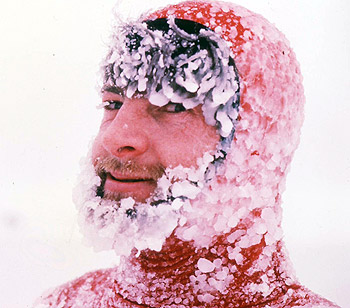 A reduction in body temperature results in impaired body office. This is seen most easily at low temperatures when you try to do something like necktie a shoe-lace or do upwards an awkward push button with fingers that are clumsy with cold. The nerve cells that transmit impulses work more slowly equally practice the muscles controlling your fingers. 12°C is the disquisitional air temperature for good manual dexterity and 8°C for touch sensitivity.
A reduction in body temperature results in impaired body office. This is seen most easily at low temperatures when you try to do something like necktie a shoe-lace or do upwards an awkward push button with fingers that are clumsy with cold. The nerve cells that transmit impulses work more slowly equally practice the muscles controlling your fingers. 12°C is the disquisitional air temperature for good manual dexterity and 8°C for touch sensitivity.
In Antarctica, I was well-nigh aware of this when axing through sea-ice to make a hole for a diver (to prepare angling nets). After five minutes or so of chopping away I had to prise my fingers of 1 hand individually away from the axe handle using a very impuissant other hand as the cold had slowed the claret flow, the upshot made worse past gripping it so tightly, this despite wearing gloves.
Depression temperatures too reduce the efficiency of pain receptors, and then putting an ice pack on a burn or sprain helps to reduce swelling and damage, only also helps with the pain.
A common symptom of cold conditions is its event on urine production. Exposure to common cold causes a reduction in claret menstruation to the surface of the skin by constriction of blood vessels. This reduces the overall book of the circulatory system then increasing the blood force per unit area. The body's response to this is to reduce the fluid volume by getting rid of some h2o via urine, an event known as "cold diuresis". When you go common cold, you want to pee.
Another reaction you lot may notice is that when the skin temperature falls below almost x°C, the surface blood vessels dilate (go wider) rather than constrict, If the temperature falls farther periods of blood vessel dilation alternate with periods of constriction, This is because your body is trying non to lose heat from the extremities, merely at the same time wants to supply the skin with blood for oxygen and nutrients. This miracle explains the red cheeks and nose characteristic of frosty conditions. Somewhen however the body stops the dilation of the claret vessels to the skin and the peel falls to the surrounding temperatures when frost nip or frost seize with teeth may occur.
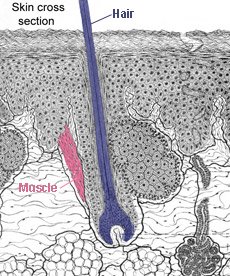
Goose bumps or pimples are an obvious sign that a person is feeling common cold. They are caused by an individual tiny erector pili musculus attached to the base of each and every hair follicle covering the body. The scientific name for this is horripilation. In homo information technology has no event equally we don't have plenty hairs to make a divergence, but in animals with a dumbo coat of fur information technology improves the insulation considerably, you may notice your cat or dog becomes noticeably larger outdoors when information technology gets beneath freezing for instance.
A last response to decreasing temperature is the increase of oestrus production. Muscular wrinkle is an inefficient process and causes much heat to be produced, so when we start to feel cold, we may begin to shiver, movements that are useless in themselves, but that generate rut equally a by-product and so help to warm us up. Shivering tin can increment the production of heat v-fold over resting.
The Sacrifice of Parts for the Greater Adept
 In conditions when the body starts to lose more than estrus than information technology can hands generate to keep all parts at the normal 37°C information technology will start to let the extremities, fingers, toes, ears, nose, and cheeks start to get cooler. At that place is still a claret catamenia to these torso parts, merely non equally much flows as does normally. In order to keep the extremities at normal torso temperature, greater claret flow would exist required which would bring cooled blood back to the body cadre then cooling the body even further. The extremities take a high surface area/book ratio, and then they lose heat very easily.
In conditions when the body starts to lose more than estrus than information technology can hands generate to keep all parts at the normal 37°C information technology will start to let the extremities, fingers, toes, ears, nose, and cheeks start to get cooler. At that place is still a claret catamenia to these torso parts, merely non equally much flows as does normally. In order to keep the extremities at normal torso temperature, greater claret flow would exist required which would bring cooled blood back to the body cadre then cooling the body even further. The extremities take a high surface area/book ratio, and then they lose heat very easily.
This reduction of blood flow is non normally a problem and happens to some extent for most people much of the time even in mildly cool atmospheric condition. In extreme or prolonged cold nevertheless it tin pb to frost-nip and even frost-bite. These are situations in which the body has made the conclusion to chance or sacrifice some of the more expendable regions to preserve the cadre temperature and then avoid decease from hypothermia.
The kickoff stage is frost nip.
Frost Nip
Most often observed at the end of the nose, tops of the ears or possibly fingers. The peel goes an unnatural looking paler, sticky shade and loses sensation. This is acquired by a lack of blood flow to those regions considering they are losing then much heat. Frost nip is an early alert sign that if left will lead to frostbite. It can be readily corrected notwithstanding by putting on actress clothing. The skidoo gloves I used in Antarctica had a large patch of sheepskin on the dorsum to hold against and warm up any frost-nipped parts, normally olfactory organ or cheeks. The important thing with frost nip is to keep an centre on your companions equally it is so easy to miss it on yourself.
Frost nip tin can actually freeze the surface layers of the skin and lead to symptoms like sun burn with the warmed skin later turning bright red and being sloughed off. There is no permanent damage.
The side by side stage is frost bite.
Frost Bite
Left unattended, frost-nip volition pb to frost bite. The difference is that in frost bite, the pare actually falls below freezing point and ice crystals class inside the alive cells of the skin killing them in the process. On rewarming, the skin swells and blisters turning blue-purple to blackness - this then forms a hardened blackness carapace. If the damage is not severe, the dead layer is sloughed off revealing new good for you skin that has grown underneath. It is however very painful. This is known as superficial frost seize with teeth.
"The temperature was -47°F and I was fool enough to take my easily out of my mitts to haul on the ropes to bring the sledges up. I started away with all 10 fingers frostbitten. They did not actually come back until we were in our tent for our night meal, and within a few hours there were two or three large blisters, upwardly to an inch long on all of them. For many days those blisters hurt frightfully"
- Apsley Ruby-red-Garrard, The Worst Journey in the World
More serious is when frostbite affects the deeper layers of muscle and bone. This almost e'er results in permanent tissue damage and may result in amputation of fingers, toes, even feet, hands and parts of the arm or leg. Many polar explorers and mountaineers have lost parts of some fingers or toes because of frostbite.
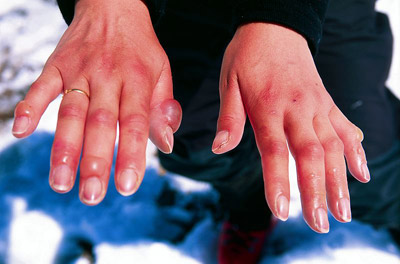 Blisters from mild frostbite
Blisters from mild frostbite
Treating severe frostbite - serious damage can be caused when desperately frostbitten body parts are rewarmed, particularly if information technology is washed too rapidly. It is therefore better to proceed the parts frozen until medical attention can be received.
Who suffers the most?
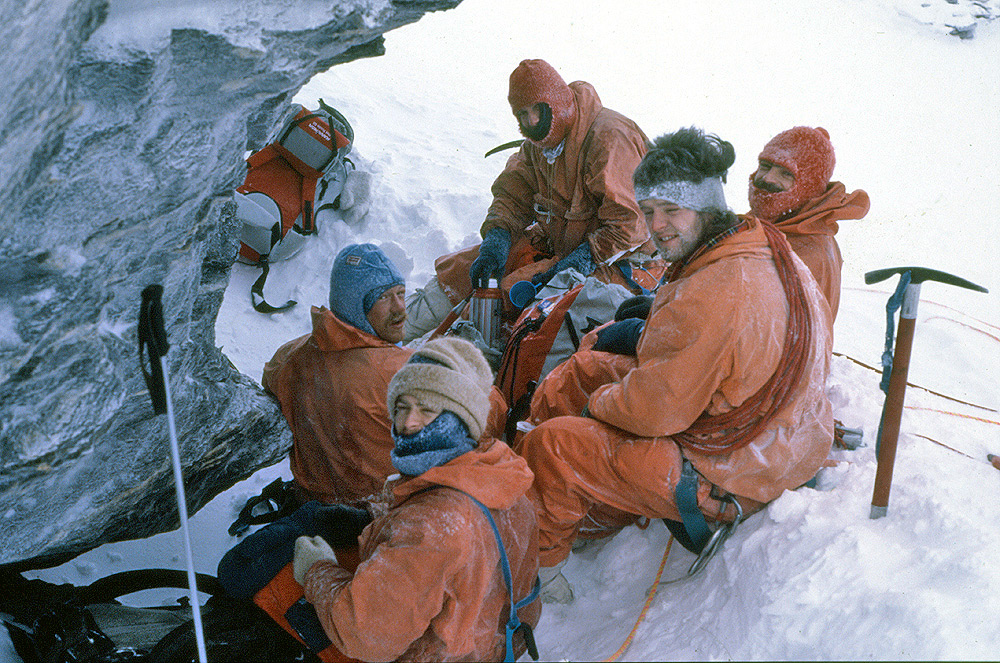 Cold weather on a modernistic society has a number of effects, most dramatically on the general population mortality charge per unit. The average mortality on a winter's day is about xv% college than on a summer's day. Common cold weather condition is directly responsible for deaths through such things as hypothermia, influenza, and pneumonia. It is also an indirect factor in a number of means such as death and injury from falls, accidents, carbon monoxide poisoning, and house fires all of which are partially attributable to cold.
Cold weather on a modernistic society has a number of effects, most dramatically on the general population mortality charge per unit. The average mortality on a winter's day is about xv% college than on a summer's day. Common cold weather condition is directly responsible for deaths through such things as hypothermia, influenza, and pneumonia. It is also an indirect factor in a number of means such as death and injury from falls, accidents, carbon monoxide poisoning, and house fires all of which are partially attributable to cold.
The gender and race of a person are of import when information technology comes to how susceptible they are to direct cold injury and hypothermia. Non-white elderly men are the most at risk, while young white women are the least at risk.
Women have a higher gradient of temperature from the pare to the torso cadre (they're more likely to take cold hands for instance) and so it seems are more able to maintain a constant body cadre temperature in cold conditions. Subcutaneous fat has a part to play as an insulator and women generally take more than practise men so helping them stay warm. On the other hand, because of the high temperature gradient from pare to core, women are more likely to suffer from surface cold injury such as frostbite.
Historic period has the highest influence, more than so than gender, with elderly people of any race having the to the lowest degree ability to survive cold injury. Studies have shown that shivering and vasoconstriction to reduce blood menses to the body periphery are not so prominent in older people, putting them at greater risk. Also as we go older, we become less able to distinguish changes in temperature and then older people are more than likely to kickoff to lose oestrus early on earlier it may become a trouble.
Adaptation plays a major part. Living in a cold environs means that people become used to the temperature and the metabolism changes to adapt. I remember quite vividly, having been in Antarctica for nearly a year, when the supply ship came in on what nosotros considered a balmy day. We winterers were walking effectually in t-shirts and loose united nations-tucked over shirt with rolled up sleeves, while those who were new arrivals were well wrapped in attached jackets and hats and still feeling cold. The two groups surveyed each other with some puzzlement.
The old idea of cold showers or baths and "washing in snow" to toughen upwardly against the cold does indeed work. When a cold snap hits a normally warm city, the mortality rate will be significantly college than the same temperature at a colder city which may show no increase in mortality at all if the common cold snap is adequately mild. These cold-related deaths differ from the immediate touch of common cold injury in that there is a time lag of near two-three days after the period when the cold snap happened.
With cheers to Morgan Fifty. Anderson for the summary at the top of this folio.
Moving picture credits, copyright pictures used by permission: Emperor penguins top of page - Warner Brothers / Killer whales - NOAA / Frostbite - "Winky from Oxford", Creative Commons license 2.0
Source: https://www.coolantarctica.com/Antarctica%20fact%20file/science/cold_humans.php
Posted by: langfordcounce.blogspot.com

0 Response to "Does Bear Grease Prevent Frostbite On Bare Skin?"
Post a Comment